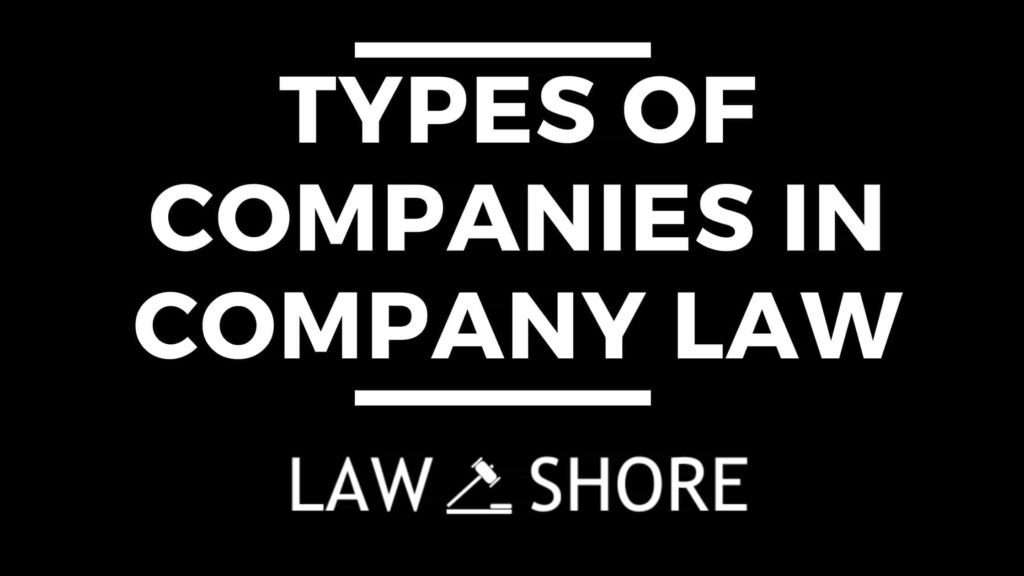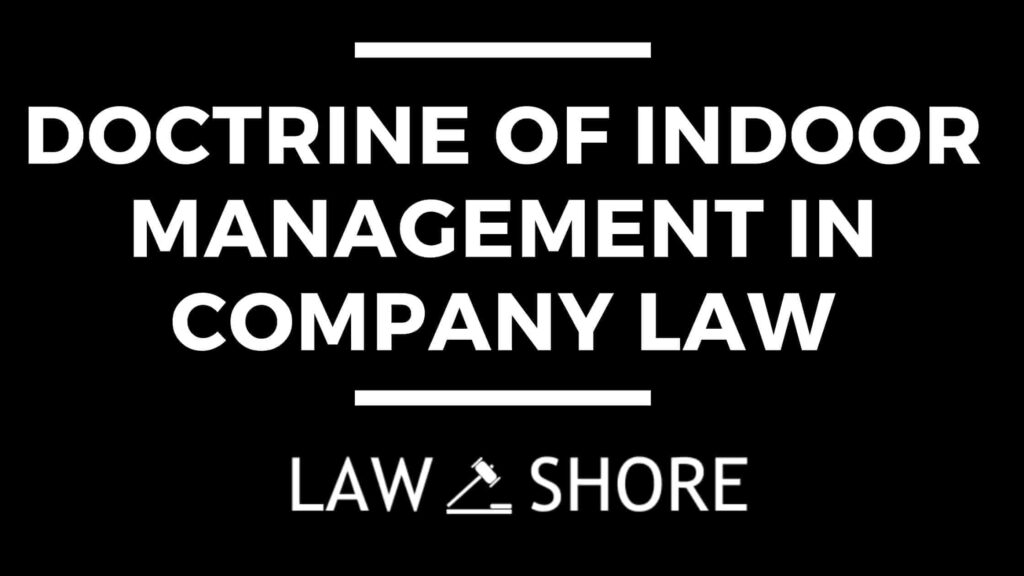Types of Companies in Company Law
Table of Contents
ToggleThe Companies Act, 2013 (the “Act”) provides the legal framework for the incorporation, regulation, and dissolution of companies in India. The Act recognizes various types of companies, each with distinct characteristics, functions, and regulatory requirements. This article aims to examine the different types of companies under the Companies Act, 2013, with references to relevant sections, key features, amendments, and case laws.
Private Company
Section Reference: Section 2(68)
Brief Features of a Private Company under the Companies Act, 2013
Minimum and Maximum Members:
- Minimum of 2 members and a maximum of 200 members (excluding employees and ex-employees holding shares).
- Section 2(68)
Restriction on Share Transfer:
- Shares are not freely transferable, and transfer is restricted by the company’s Articles of Association.
- Section 2(68)
Prohibition on Public Subscription:
- Cannot invite the public to subscribe to its shares or debentures.
- Section 2(68)
Limited Liability:
- Shareholders’ liability is limited to the unpaid amount on their shares.
- Section 2(68)
Directors:
- Must have at least 2 directors
- Section 149
Articles of Association (AoA):
- Must have its own Articles of Association outlining internal management and rules.
- Section 5
Perpetual Succession:
- Continues to exist despite changes in membership or ownership.
- Section 9
Company Name:
- Must end with the words “Private Limited” (Pvt Ltd.).
- Section 12
Financial Reporting:
- Must file annual financial statements with the Registrar of Companies (RoC), but less stringent than public companies.
- Section 137
Debenture Issuance:
- Can issue debentures, but they are not available to the general public.
- Section 71
Meetings and Governance:
- Must hold an Annual General Meeting (AGM) but has more flexible governance rules compared to public companies.
- Section 96
Conversion to Public Company:
- Can convert into a public company through a special resolution.
- Section 18
Amendments:
Earlier, the Companies Act, 1956 had a restriction that a private company could not have more than 50 members. The 2013 Act increased this to 200 members, which was a significant liberalization of the rules.
Illustration:
A Ltd., a family-owned business, has 150 shareholders and restricts the transferability of shares to outsiders. This company qualifies as a private company under Section 2(68).
Case Law:
Rajahmundry Electric Supply Corporation Ltd. v. A. Nageswara Rao (1956): The Supreme Court held that in the case of private companies, the limitation on the right to transfer shares is critical in determining the nature of the company. If the company has no such restriction, it cannot be classified as a private company under the Companies Act.
Public Company
Section Reference: Section 2(71)
Key Features of a Public Company under the Companies Act, 2013
A Public Company under the Companies Act, 2013 is defined in Section 2(71), and it has several distinct characteristics that differentiate it from private companies. Below are the key features of a public company:
Minimum Number of Members
- A public company must have at least 7 members (individuals or legal entities).
- There is no upper limit on the number of members.
Section Reference: Section 2(71)
No Restriction on Share Transfer
- Shares of a public company can be freely transferred, subject to compliance with regulatory frameworks like SEBI and stock exchange regulations if listed.
- The transfer of shares is not restricted as in private companies.
Section Reference: Section 2(71)
Invitation to Public to Subscribe Shares
- A public company is allowed to invite the public to subscribe to its shares, debentures, or other securities.
- This is a key feature distinguishing public companies from private companies, as it enables them to raise capital from the public.
Section Reference: Section 2(71)
- Limited Liability
Like all companies, a public company offers limited liability to its shareholders. Shareholders are only liable up to the amount unpaid on their shares. - This means that creditors cannot claim personal assets of shareholders in case of financial difficulties.
Section Reference: Section 2(71)
Directors
- A public company must have at least 3 directors.
- The company can have a maximum of 15 directors (unless increased through a special resolution).
Section Reference: Section 149
Memorandum and Articles of Association (AoA)
- A public company must adopt a Memorandum of Association and Articles of Association that lay out the company’s objectives, powers, and the rules for internal governance.
- The Memorandum defines the company’s scope, while the Articles govern its day-to-day management.
Section Reference: Section 4 (Memorandum), Section 5 (Articles)
Perpetual Succession
- A public company enjoys perpetual succession, meaning it continues to exist even if members or shareholders change, or if shareholders die, leaving the company’s existence unaffected.
Section Reference: Section 9
Company Name
- The name of a public company must end with the word “Limited” (as opposed to a private company, which ends with “Private Limited”).
- This indicates its status as a public company and differentiates it from private companies.
Section Reference: Section 12
Financial Reporting and Compliance
- Public companies are required to comply with stringent financial disclosure and corporate governance norms, including filing annual financial statements with the Registrar of Companies (RoC).
- They are subject to audit requirements and frequent reporting to regulatory authorities such as SEBI if listed.
Section Reference: Section 137 (filing financial statements), Section 204 (audit requirements)
Debenture Issuance
- A public company can issue debentures (debt securities) to raise capital from the public.
- The process involves compliance with detailed disclosure and regulatory frameworks, particularly when the debentures are offered to the public.
Section Reference: Section 71
Annual General Meeting (AGM)
- A public company must hold an Annual General Meeting (AGM) every year to discuss company matters, financial results, and declare dividends.
- Failure to hold an AGM can lead to penalties and non-compliance issues.
Section Reference: Section 96
Board of Directors
- Public companies are managed by a Board of Directors.
- The Board typically consists of executive and non-executive directors, including independent directors, ensuring transparency and governance.
- They are required to follow corporate governance norms as per the Companies Act, 2013 and SEBI guidelines (for listed companies).
Section Reference: Section 149 (directors’ appointment)
Regulatory Oversight
- Public companies are subject to extensive regulatory oversight by various authorities, including the Registrar of Companies (RoC), Securities and Exchange Board of India (SEBI) (if listed), and other relevant authorities.
- Listed public companies must also comply with stock exchange regulations and disclosure norms.
Section Reference: SEBI Guidelines, Companies Act, 2013
Ability to Raise Capital from the Public
- One of the key advantages of a public company is its ability to raise significant amounts of capital by issuing shares and debentures to the public or by getting listed on a stock exchange.
- This is essential for large businesses that need large-scale funding for growth, expansion, and operations.
Section Reference: Section 2(71)
Amendments:
The provisions related to public companies under the Companies Act, 2013 are largely consistent with the previous law. However, the Act mandates stricter governance and financial reporting norms for public companies, including audit requirements and more frequent disclosures.
Illustration:
Reliance Industries Ltd., a company listed on the Bombay Stock Exchange (BSE), qualifies as a public company under Section 2(71) because it has more than 7 members and issues shares to the public.
Case Law:
Nirmal Singh v. Punjab National Bank Ltd. (2000): The court observed that a public company has far more extensive powers than a private company, including the ability to raise capital from the public. The company must follow the provisions for public companies under the Act, including adherence to the Securities and Exchange Board of India (SEBI) regulations if listed.
One Person Company (OPC)
Section Reference: Section 2(62)
Key Features:
The One Person Company (OPC) was introduced under the Companies Act, 2013 to encourage single entrepreneurs to establish a company. An OPC has the following features:
- It can have only one member (individual) and one director.
- It must comply with certain rules that differ from traditional private companies.
- The OPC allows for the continuity of the business with ease, as the sole member’s legal status is distinct from the individual.
Amendments:
OPC was a new concept introduced in the Companies Act, 2013. Since its inception, there have been amendments allowing OPCs to convert into private or public companies, making the legal landscape more flexible.
Illustration:
B Ltd., a sole proprietorship, has been converted into a One Person Company by registering under Section 2(62) of the Companies Act, 2013, with a single member (Mr. A), who also serves as the director.
Case Law:
The Ministry of Corporate Affairs v. A.N. Enterprises (2020): In this case, the Delhi High Court held that an OPC is entitled to all the benefits of a private company under the Companies Act, 2013, provided it meets the specified criteria.
Non-Profit Company
Section Reference: Section 8
Key Features:
A Non-Profit Company is formed for promoting charity, education, religion, or any other objective beneficial to the public at large. It can:
- Apply its profits solely for the promotion of its objects.
- Not pay dividends to its members.
- Be incorporated as a company limited by guarantee or shares (but no share capital or profit distribution is allowed).
Examples: Charitable organizations, foundations.
Amendments:
Non-profit companies are primarily governed by Section 8 of the Companies Act, 2013. The Act specifies the compliance requirements for such companies, which include financial disclosure and adherence to tax-exempt status.
Illustration:
ABC Foundation is registered under Section 8 of the Companies Act, 2013, to promote education among underprivileged children. It does not distribute profits but reinvests them in its social programs.
Case Law:
Indian Express Newspapers Ltd. v. Union of India (1985): The Supreme Court emphasized that Section 8 companies must fulfill their charitable objectives without distributing any profits to members. The case clarified the scope of “non-profit” in company law.
Government Company
Section Reference: Section 2(45)
Key Features:
A Government Company is defined as any company in which the government holds at least 51% of the paid-up share capital. Key features:
- The government or government bodies are shareholders.
- It can be established for commercial purposes or public service.
- Subject to specific government regulations and audit procedures.
Amendments:
The Companies Act, 2013, retained the definition of a government company from the 1956 Act but placed greater emphasis on transparency and accountability, requiring more stringent audits and reports.
Illustration:
Oil and Natural Gas Corporation Ltd. (ONGC) is a government company as the Indian government holds more than 51% of its shares.
Case Law:
Union of India v. UCO Bank (1999): The Supreme Court clarified that even if the government is a major shareholder, the government company is subject to corporate governance norms under the Companies Act, including filing financial reports and compliance with audit standards.
Company Limited by Shares
A Company Limited by Shares is one in which the liability of its members is limited to the amount unpaid on the shares they hold. The most common form of company, especially for profit-oriented businesses, it is usually formed for conducting commercial activities.
Features:
- Liability: Shareholders’ liability is limited to the amount unpaid on their shares.
- Capital Structure: Raised through the issuance of shares to members.
- Profit Distribution: Profits can be distributed among shareholders in the form of dividends.
- Transferability: Shares are transferable (subject to certain restrictions in case of private companies).
- Management: Managed by a board of directors, elected by the shareholders.
Company Limited by Guarantee
A Company Limited by Guarantee does not have share capital. Instead of shareholders, it has members who guarantee to contribute a certain amount to the company’s assets if it winds up. This structure is typically used for non-profit organizations, charities, clubs, and associations.
Features:
- Liability: Members’ liability is limited to the amount they agree to contribute in case of liquidation.
- Capital Structure: No share capital; members’ guarantees are the primary source of funding.
- Profit Distribution: Profits cannot be distributed to members; they must be reinvested in the company’s activities.
- Transferability: No shares to transfer.
- Management: Managed by a board of directors, but the members’ control is typically stronger as they set the objectives.
Unlimited Company
An Unlimited Company is a company where the liability of its members is unlimited, meaning that if the company’s assets are insufficient to meet its debts, the personal assets of its members can be used to cover the shortfall. This type of company is relatively rare in India.
Features:
- Liability: Members have unlimited liability for the company’s debts.
- Capital Structure: Can have share capital or no capital at all.
- Profit Distribution: Profits can be distributed among shareholders if there are any.
- Transferability: Shares (if issued) can be transferred, but this may be restricted by the company’s Articles of Association.
- Management: Managed by a board of directors, with the shareholders holding ultimate control.
Tabular Comparison of Types of Companies under the Companies Act, 2013
Type of Company | Key Features | Minimum Number of Members | Maximum Number of Members | Public Subscription of Shares | Liability |
|---|---|---|---|---|---|
Private Company | No public share subscription, restricted share transfer, limited liability. | 2 | 200 | Not allowed | Limited to share capital |
Public Company | Can raise capital from the public, no restriction on share transfer, extensive governance requirements. | 7 | No limit | Allowed | Limited to share capital |
One Person Company (OPC) | Only one member and director, simple structure, allows for continuity of business. | 1 | 1 | Not allowed | Limited to share capital |
Non-Profit Company | Charitable purpose, no profit distribution, cannot pay dividends. | 2 | No limit | Not allowed | Limited to assets |
Government Company | Government holds at least 51% shares, subject to special audit and regulatory norms. | 2 | No limit | Allowed | Limited to share capital |
Comparison of Company Limited by Shares, Guarantee, and Unlimited Company: Types of Companies
Feature | Company Limited by Shares | Company Limited by Guarantee | Unlimited Company |
Liability of Members | Limited to the unpaid amount on their shares. | Limited to the amount guaranteed in case of winding up. | Unlimited; members’ personal assets can be used. |
Capital Structure | Issued shares representing ownership in the company. | No share capital, but members provide guarantees. | May or may not have share capital. |
Profit Distribution | Profits can be distributed as dividends. | Profits are reinvested; cannot be distributed. | Profits can be distributed to members/shareholders. |
Transferability of Shares | Shares are freely transferable (except in private companies, which may restrict transfer). | No shares; membership cannot be transferred. | Shares (if any) can be transferred (may be restricted). |
Membership/Shareholding | Shareholders own the company. | Members are the guarantors and not owners in the conventional sense. | Shareholders or members, depending on whether the company has shares. |
Use Case | Common for profit-making businesses. | Common for non-profit organizations, clubs, or associations. | Rare, often used for special purposes (e.g., family businesses). |
Legal Entity | Separate legal entity. | Separate legal entity. | Separate legal entity. |
Management | Managed by a board of directors elected by shareholders. | Managed by a board of directors; decisions made by members. | Managed by a board of directors. |
Ability to Raise Funds | Can raise capital by issuing shares. | Cannot raise capital through shares, only via donations or guarantees. | Can raise funds via share issuance or other means. |
- Company Limited by Shares is the most common form for profit-driven businesses and allows for easier capital generation via share issuance.
- Company Limited by Guarantee is suited for non-profits or social enterprises where profits are reinvested, and members’ liability is restricted to a nominal amount.
- Unlimited Company is less common and is usually adopted when members are willing to accept personal liability for the company’s debts, which can be beneficial in certain industries or with specific regulatory requirements.
Conclusion
The Companies Act, 2013 categorizes types of companies companies into various types based on the size, ownership structure, and objectives. Each type of company has distinct features, regulatory requirements, and compliance obligations. The Act provides a broad and flexible framework that accommodates both small-scale entrepreneurs and large public corporations. With its evolving nature, the Act continues to adapt to the needs of the corporate world, ensuring transparency, accountability, and growth in the corporate sector. Moving forward it is expected that more types of companies will be created.
Explore Law Shore: law notes today and take the first step toward mastering the fundamentals of law with ease.

After Completing my LLB hons, I started writing content about legal concepts and case laws. I finally started Law Shore in 2024 with an aim to help other students and lawyers.



